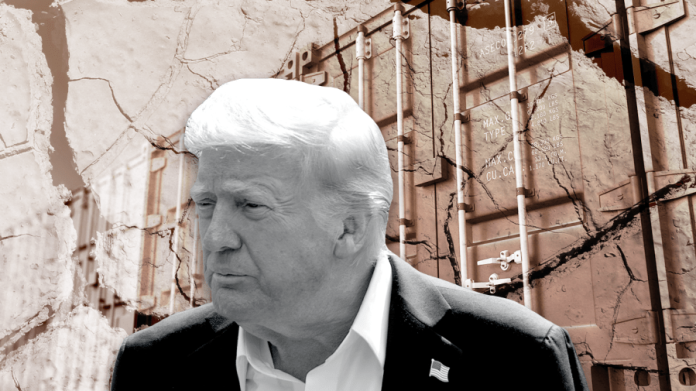
The ongoing round of Trump tariffs is certain to leave some scars on the nation. But what kind?
To date, tariffs have created an environment of uncertainty that has rattled economic markets and kept nations around the world, as well as companies and consumers, on edge. The biggest fear is that tariffs will stoke inflation, or push the economy into a recession, either of which would bring a cavalcade of economic woes and concerns.
This uncertainty has driven the Federal Reserve to keep interest rates higher than the president wants them to be. Higher interest rates mean that the nation’s debt, now around $37 trillion, is more expensive to service. For example, dropping interest rates from their current level of around 4.2 percent for 10-year Treasury notes to 2 percent would save the government more than $800 billion per year in interest. Although these savings costs would be gradual, taking several years to be realized, lower interest rates would certainly reduce the government’s budget deficit.
If Trump were to stop playing tariff games with other countries and perhaps stick with his initial 10 percent baseline tariff — which most countries appear willing to absorb — the Federal Reserve may then be willing to abide by his wishes and consider lowering interest rates.
Are tariffs guaranteed to increase inflation or cause a recession? To answer this question, one must look at how tariffs get absorbed into the economy.
Tariffs are nothing more than a tax collected by the government on imported goods. To producers and manufacturers, this is a direct cost added to their bottom line. If producers and manufacturers keep their selling prices flat and absorb such costs, their profit margins are reduced.
Alternatively, tariffs can be passed along to consumers in the form of higher prices. This takes money out of consumers’ pockets and gives it to the federal government. In other words, higher prices on imported goods driven by tariffs represent higher taxes. Though the One Big Beautiful Bill Act touted lower taxes, tariffs on imported goods take some of these tax savings away and return them to the government.
Of course, if consumers only purchase items that produced domestically, their effective tariff is zero. The challenge is that the types of goods imported are vast. For example, around 60 percent of fruits and 38 percent of vegetables consumed in 2021 were imported. There is simply insufficient domestic production capacity (both in human capital and land) to meet this demand, which means prices will rise for domestic produce as well.
Tariffs will create a new market equilibrium. Higher prices will invariably shift consumer preferences and buying patterns. Given that consumers tend to be price sensitive, they may chase lower prices for the same goods by purchasing different brands, opt to purchase different goods (for example, switching from beef to chicken), or simply not make purchases. The net effect is less consumer spending, which invariably will lead to a shrinking economy.
Recent GDP and labor force numbers support this trend, which will only accelerate as the tariffs become more widespread and ingrained into the economy.
The economic numbers will also worsen as the U.S. is perceived as an unwelcoming destination for foreign travelers. The number of tourists from other countries was down 12 percent in March 2025 compared to March 2024, with those from Canada expected to decline by 20 percent in 2025. Depressed tourism numbers are certain to put downward pressure on the service trade surplus, which stood at $152 billion for the first six months of 2025.
Moreover, with fewer people spending money in hotels, restaurants and entertainment venues, destination cities such as Washington, New York, Boston, Chicago and Honolulu are sure to see a drop in tax revenue. The ripple effect of lower state and city tax revenue will put additional downward economic pressures on all such cities, and the entire country.
Tariffs are providing short-term bumps in federal revenue. Even just the threat of tariffs has given countries the incentive to invest in America, the so called “deals” that the administration is cutting. What remains unclear is how many of these promised concessions were previously planned. (Hence the easy offerings to appease the administration).
Yet with the U.S. economy a highly complex system, significant disruptions in one sector will almost certainly have effects across other sectors. For example, Spain and India have cancelled orders for F-35 fighter planes manufactured by Lockheed Martin. Switzerland is pondering a similar decision. Note that India’s tariff rate is 50 percent and Switzerland’s is 39 percent, whereas Spain’s is a relatively modest 15 percent.
Before anyone takes a victory lap to celebrate what the tariffs bring in, first measure what the tariffs are taking away. Among the intangibles, this includes an erosion of international relations and a lack of trust with global partners. These will live on long after the tariffs have been pared down or rescinded and the current administration is gone, independent of whether tariffs stoked inflation or brought on a recession.
Sheldon H. Jacobson, Ph.D., is a computer science professor in the Grainger College of Engineering at the University of Illinois Urbana-Champaign. As a data scientist, he uses his expertise in risk-based analytics to address problems in public policy. He is a native of Montreal.

